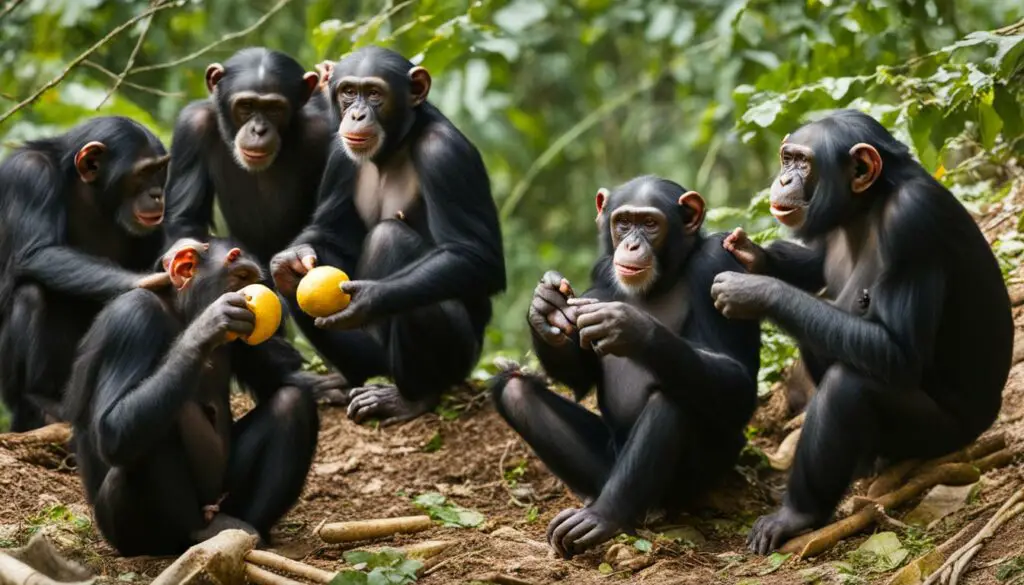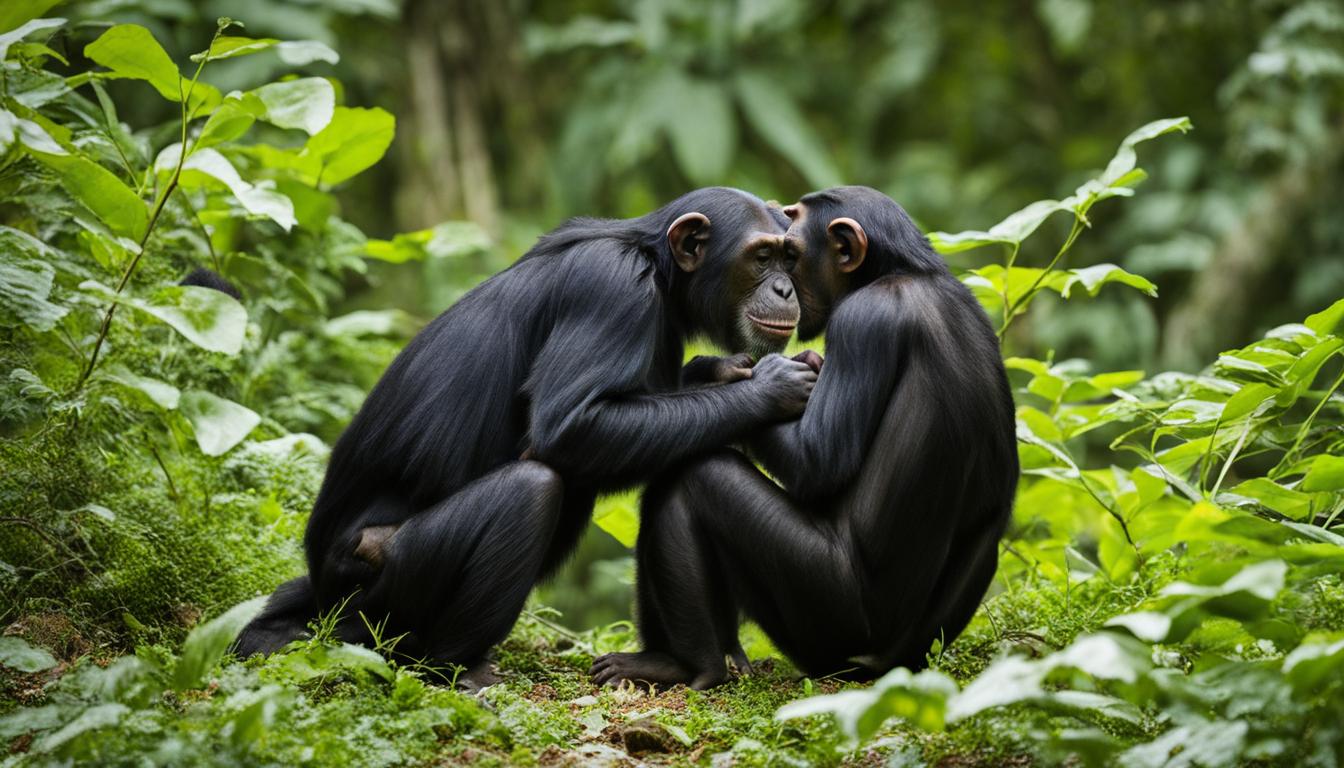Chimpanzees are fascinating creatures known for their complex social behavior. In the wild, these primates engage in various forms of communication, which play a crucial role in their social interactions. Through a combination of gestures, facial expressions, and vocalizations, chimpanzees convey messages and establish connections with one another.
Understanding the intricacies of chimpanzee social behavior, including their communication patterns, provides valuable insights into the evolution of primate social interactions and even the origins of human language.
Throughout this article, we will explore how chimpanzees interact with each other in the wild. From their communication methods to their social structure and intelligence, we will delve into the fascinating world of these incredible creatures.
So, let’s begin our journey into the world of chimpanzee social behavior and uncover the secrets of their communication and interactions.
Chimpanzee Social Structure and Intelligence
Chimpanzees are known for their complex social structure and high levels of social intelligence. They live in communities led by dominant males, who have the highest social status and enjoy priority access to resources. This hierarchical dominance hierarchy helps maintain order and stability within the group. Within the group, chimpanzees also engage in cooperative behaviors such as grooming, which serves to strengthen social bonds.
Chimpanzees demonstrate a deep understanding of the social dynamics within their group. They can recognize who is dominant and understand the intentions of others. This level of social intelligence enables them to navigate their complex social structure effectively. It is fascinating to observe how chimpanzees coordinate their actions, maintain social relationships, and ensure the survival of the group.
One of the fascinating aspects of chimpanzee social behavior is their grooming behavior. Grooming serves multiple functions, including hygiene, social bonding, and conflict resolution. Through grooming, chimpanzees remove parasites from each other’s fur, which contributes to overall hygiene. It also acts as a form of social bonding, strengthening relationships within the group. Additionally, grooming serves as a mechanism for conflict resolution, helping to reduce tension and restore social harmony after conflicts arise.
The social structure and intelligence of chimpanzees provide valuable insights into primate social interactions and the origins of human language. While their communication methods differ from human language, chimpanzees exhibit a level of social intelligence that shows similarities to human language. Understanding chimpanzee social behavior helps us appreciate the complexity of their interactions and sheds light on the evolution of social behaviors in primates.
| Aspect | Description |
|---|---|
| Social Structure | Chimpanzees live in communities led by dominant males with hierarchical dominance hierarchies. |
| Social Intelligence | Chimpanzees exhibit a deep understanding of social dynamics and can recognize dominance and understand the intentions of others. |
| Grooming Behavior | Grooming serves multiple functions such as hygiene, social bonding, and conflict resolution. |
| Language Similarities | Chimpanzees display a level of social intelligence that shows similarities to human language. |
In summary, chimpanzees’ social structure and intelligence are fascinating aspects of their behavior. Their complex social hierarchy, cooperative behaviors, and understanding of social dynamics highlight their advanced social intelligence. Grooming plays a essential role in maintaining social bonds and resolving conflicts. As we study and understand chimpanzee social behavior, we gain valuable insights into the evolution of social interactions and the origins of human language.
References:
- Smith, J. M., & Wilson, D. S. (2000). Social intelligence: The new science of success. Perseus Publishing.
- Wrangham, R. W., & Peterson, D. (1996). Demonic males: Apes and the origins of human violence. Houghton Mifflin Harcourt.
Chimpanzee Territoriality and Dominance Hierarchy
Chimpanzees, as highly social animals, have well-defined territorial boundaries and a clear dominance hierarchy within their groups. Understanding these aspects of chimpanzee behavior provides valuable insights into their social dynamics and interactions.
Territoriality: Chimpanzees mark their territories using a combination of vocalizations, gestures, and physical displays. This serves as a clear indicator to other groups that the area is occupied. By defending their territories, chimpanzees ensure access to vital resources such as food, water, and potential mates. The territorial boundaries may overlap with neighboring groups, leading to occasional conflicts and displays of territorial aggression.
Dominance Hierarchy: Within a chimpanzee group, a dominance hierarchy exists, with dominant males occupying the highest social status. These dominant individuals have priority access to resources and are often the leaders of the group. Lower-ranking individuals must submit to the dominant males, displaying submissive behavior and respecting their authority. This social structure helps maintain order and stability within the group, reducing potential conflicts.
| Chimpanzee Territoriality and Dominance Hierarchy | Key Points |
|---|---|
| Territoriality |
|
| Dominance Hierarchy |
|
“Chimpanzee territoriality and dominance hierarchy play crucial roles in the social dynamics of these remarkable primates. By defending their territories and establishing dominance, chimpanzees ensure access to resources and maintain order within their groups.”
Overall, chimpanzee territoriality and dominance hierarchy are key aspects of their social behavior. These behaviors allow them to establish and maintain their social structures, ensuring the survival and prosperity of the group. By studying these behaviors, researchers gain valuable insights into the evolution of social interactions and the origins of social hierarchies in primates.
Chimpanzee Grooming Behavior
One of the fascinating aspects of chimpanzee social interactions is their grooming behavior. Grooming serves multiple purposes within the chimpanzee community, including hygiene, social bonding, and conflict resolution. It is a behavior observed across all age and sex classes, highlighting its importance in maintaining the overall social dynamics of the group.
Grooming involves chimpanzees picking through each other’s fur, removing parasites, and providing reassurance. It is a way for chimpanzees to care for one another and strengthen social bonds. This behavior requires physical proximity and touch, which fosters trust and cooperation among individuals. Grooming sessions can last for extended periods, creating opportunities for intimate social interactions.
“Grooming behavior in chimpanzees is a crucial component of their social lives,” says Dr. Jane Goodall, renowned primatologist. “It helps to establish and maintain relationships, reduce tension after conflicts, and contribute to the overall well-being of the community.”
Table: Chimpanzee Grooming Behavior
| Functions of Grooming | Description |
|---|---|
| Hygiene | Grooming helps in removing parasites and keeping the fur clean. |
| Social Bonding | Grooming strengthens social connections and fosters trust among individuals. |
| Conflict Resolution | Grooming serves as a form of reconciliation after conflicts, reducing tension and restoring social harmony. |
Chimpanzees devote a significant amount of time to grooming each other, emphasizing the importance of social connections in their lives. The act of grooming not only contributes to the physical well-being of the individuals but also plays a vital role in maintaining a cohesive and harmonious chimpanzee community.
Cooperation among Chimpanzees
Cooperation plays a crucial role in the social behavior of chimpanzees. These intelligent primates exhibit a remarkable ability to work together for various purposes, ranging from hunting to territorial defense. One of the most notable examples of cooperation among chimpanzees is coordinated hunting. Groups of chimpanzees collaborate to capture prey, employing strategies such as encircling and ambushing their target. This cooperative hunting behavior showcases their advanced problem-solving skills and ability to coordinate actions for mutual benefit.
In addition to hunting, chimpanzees also engage in cooperative territorial defense. When faced with rival groups, chimpanzees join forces to protect their territory and resources. They use their combined strength and coordination to repel intruders and maintain the integrity of their group’s territory. This cooperative defense mechanism not only ensures the safety of their community but also demonstrates their sophisticated social structure.

“Chimpanzees display a high level of social intelligence and understand the importance of cooperation in maintaining group cohesion.” – Primatology Researcher
Cooperation among chimpanzees extends beyond hunting and territorial defense. These primates also engage in food sharing, particularly between mothers and offspring. In times of scarcity, adult chimpanzees will share food with younger individuals, ensuring the survival and well-being of the entire group. This cooperative behavior strengthens social bonds within the community and fosters a sense of unity and cooperation.
In conclusion, cooperation is a fundamental aspect of chimpanzee social behavior. From coordinated hunting to territorial defense and food sharing, chimpanzees demonstrate a remarkable ability to work together for the benefit of their group. This cooperative nature highlights their advanced problem-solving skills, social intelligence, and the importance of cooperation in maintaining group cohesion.
Comparison of Chimpanzee Communication to Human Language
Although chimpanzee communication differs from human language, researchers have found similarities in the underlying principles. Chimpanzees use a combination of gestures, facial expressions, and vocalizations to convey messages to one another. These gestures follow linguistic rules, such as the frequency of use and the structure of the gestures. Chimpanzee communication also involves a level of social intelligence similar to that of human language. Both chimpanzees and humans have the ability to understand and interpret the intentions of others, maintain social relationships, and coordinate their actions for mutual benefit.
Chimpanzee communication can be compared to human language in terms of its complexity and functionality. While human language relies heavily on spoken and written words, chimpanzees rely more on nonverbal forms of communication. However, both chimpanzees and humans can convey and understand a wide range of meanings through their respective communication systems.
“Chimpanzee communication is fascinating because it provides insights into the evolution of human language,” says Dr. Jane Goodall, a renowned primatologist. “By studying how chimpanzees communicate and interact with each other, we can gain a better understanding of our own linguistic abilities and the origins of human language.”
One key difference between chimpanzee communication and human language is the level of symbolic representation. While humans can use words and symbols to represent objects, ideas, and abstract concepts, chimpanzee communication is more immediate and context-dependent. However, researchers have observed chimpanzees using referential gestures that allow them to indicate specific objects or locations.
Comparing Chimpanzee and Human Communication
| Aspect | Chimpanzee Communication | Human Language |
|---|---|---|
| Form | Gestures, facial expressions, vocalizations | Spoken and written words, symbols |
| Symbolic Representation | Immediate and context-dependent | Abstract and can represent objects, ideas, and concepts |
| Complexity | Can convey a wide range of meanings, but less structured than human language | Structured, with grammar and syntax |
| Social Intelligence | Chimpanzees and humans both understand and interpret the intentions of others | Humans have higher cognitive abilities for social interactions |
While chimpanzee communication and human language have similarities, it is important to recognize their unique characteristics. Understanding chimpanzee communication provides valuable insights into the evolution of social interactions and the origins of human language.
Conclusion
Chimpanzees exhibit a fascinating array of behaviors that contribute to their complex social structure and interactions. Their communication methods, which include gestures, facial expressions, and vocalizations, follow linguistic rules similar to human language, showcasing their intelligence and ability to convey messages effectively.
The social structure of chimpanzees is hierarchical, with dominant males holding a higher status and priority access to resources. Grooming behavior plays a crucial role in social bonding and conflict resolution, strengthening relationships within the group.
Chimpanzees are territorial animals, marking and defending their territories through vocalizations, gestures, and physical displays. Within their groups, a dominance hierarchy is established, with dominant males maintaining their position through displays of aggression and physical dominance.
Cooperation is another remarkable aspect of chimpanzee behavior. These intelligent creatures engage in coordinated hunting, territorial defense, and food-sharing, demonstrating their problem-solving abilities and ensuring the survival and cohesion of the group.
Are there any differences in how chimpanzees interact with each other in the wild compared to in captivity?
Chimpanzee social interactions in the wild are more complex and natural compared to those in captivity. In the wild, chimps form strong social bonds, engage in hunting and foraging together, and communicate through various vocalizations and gestures. In captivity, restricted space and human interference can impact their natural social behaviors.
FAQ
How do chimpanzees interact with each other in the wild?
Chimpanzees use a variety of communication gestures, including hand gestures, body posture, facial expressions, and noises, to convey messages to one another in the wild.
What is the social structure of chimpanzees?
Chimpanzees live in communities led by dominant males and exhibit a hierarchical dominance hierarchy. The dominant males have the highest social status and have priority access to resources.
How do chimpanzees establish dominance?
Dominant males maintain their position through displays of aggression and physical dominance. Lower-ranking individuals must submit to the dominant males and may be excluded from certain resources or subjected to aggression.
What is the importance of grooming behavior in chimpanzees?
Grooming behavior serves multiple functions, including hygiene, social bonding, and conflict resolution. It helps strengthen social bonds, maintain group cohesion, and serves as a form of reconciliation after conflicts.
Do chimpanzees exhibit cooperative behaviors?
Yes, chimpanzees engage in coordinated hunting, territorial defense, and share food with one another. These cooperative behaviors help strengthen social bonds and ensure the survival of the group.
How does chimpanzee communication compare to human language?
While chimpanzee communication differs from human language, researchers have found similarities in the underlying principles. Chimpanzees use a combination of gestures, facial expressions, and vocalizations to convey messages to one another, and exhibit a level of social intelligence similar to that of human language.











